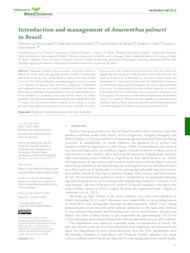Introduction and management of Amaranthus palmeri in Brazil.
Introduction and management of Amaranthus palmeri in Brazil.
Author(s): GAZZIERO, D. L. P.; SILVA, A. F. da; CERDEIRA, A. L.
Summary: Glyphosate-resistant palmer amaranth, Amaranthus palmeri, a difficult to control weed with aggressive growth, capable of causing large yield losses in annual crops, was identified in Brazil, in the state of Mato Grosso, in 2015. After notification, an epidemiological survey was carried out to identify the place of entry and area of dispersion. Containment and eradication measures were quickly established by state and federal phytosanitary authorities through legislative measures. After identification, it was classified as a quarantine weed under official control. The Palmer amaranth Containment and Eradication Committee was established in order to support the phytosanitary defense agencies in the actions to combat the weed. State agricultural inspectors were trained to identify the species and survey the State. Actions aimed at the farmers were also carried out, highlighting the importance of identification, control and awareness. The weed was found in six municipalities in 10 farms in Mato Grosso. The importation of a used cotton harvester from the United States of America and its internal transit were found to be the main route of entry and spread of the weed. The weed spread to the State of Mato Grosso do Sul, in 2022 and was detected in two municipalities and six properties. A detailed survey is on progress. It is necessary to understand movement routes and establish measures to contain it. Effective measures regarding the importation and cleaning of used machinery needs to be adopted to avoid weed seed dispersal, and Federal legislation is needed to contain and eradicate the weed.
Publication year: 2023
Types of publication: Journal article
Unit: Embrapa Soybean
Keywords: Erva Daninha, Glyphosate, Harvesters, Herbicida, Herbicide-resistant weeds, Planta daninha
Observation
Some of Embrapa's publications are published as ePub files. To read them, use or download one of the following free software options to your computer or mobile device. Android: Google Play Books; IOS: iBooks; Windows and Linux: Calibre.
Access other publications
Access the Agricultural Research Database (BDPA) to consult Embrapa's full library collection and records.
Visit Embrapa Bookstore to purchase books and other publications sold by Embrapa.

